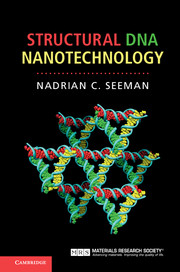Book contents
- Frontmatter
- Contents
- Preface
- 1 The origin of structural DNA nanotechnology
- 2 The design of DNA sequences for branched systems
- 3 Motif design based on reciprocal exchange
- 4 Single-stranded DNA topology and motif design
- 5 Experimental techniques
- 6 A short historical interlude: the search for robust DNA motifs
- 7 Combining DNA motifs into larger multi-component constructs
- 8 DNA nanomechanical devices
- 9 DNA origami and DNA bricks
- 10 Combining structure and motion
- 11 Self-replicating systems
- 12 Computing with DNA
- 13 Not just plain vanilla DNA nanotechnology: other pairings, other backbones
- 14 DNA nanotechnology organizing other materials
- Afterword
- Index
- References
9 - DNA origami and DNA bricks
Published online by Cambridge University Press: 05 December 2015
- Frontmatter
- Contents
- Preface
- 1 The origin of structural DNA nanotechnology
- 2 The design of DNA sequences for branched systems
- 3 Motif design based on reciprocal exchange
- 4 Single-stranded DNA topology and motif design
- 5 Experimental techniques
- 6 A short historical interlude: the search for robust DNA motifs
- 7 Combining DNA motifs into larger multi-component constructs
- 8 DNA nanomechanical devices
- 9 DNA origami and DNA bricks
- 10 Combining structure and motion
- 11 Self-replicating systems
- 12 Computing with DNA
- 13 Not just plain vanilla DNA nanotechnology: other pairings, other backbones
- 14 DNA nanotechnology organizing other materials
- Afterword
- Index
- References
Summary
One of the central concepts in structural science is the notion of resolution. What we're talking about here is the extent of detail or precision with which we wish to work. Resolution is usually thought of as the detail level of analysis, particularly optical analysis, but it can also refer to the detail level of construction. For example, when I was a “small molecule” crystallographer, it was useful to have a mental picture of my structures where the rulings were approximately every 10 picometers. My structures themselves were built up from Fourier components whose crests were separated by about 80 picometers (their nominal resolution) or more, but I was able to find meaningful differences between things such as bond lengths that were about 10 picometers different from each other. It is usually more useful to think of macromolecular crystals (resolution typically 200–400 picometers) more crudely, say in a world where the rulings are around 50 picometers apart. Resolution should fit the subject appropriately: if we were building a house with 5 × 10 × 15 cm bricks, this type of thinking would be far too detailed; we would be wasting out time thinking in a world with rulings closer than about a centimeter. Biology is replete with phenomena that take place on multiple distance scales, everywhere from the sub-nanometer scale (e.g., simple enzymatic reactions) to the nanometer scale (e.g., transcription, translation, recombination, and other aspects of nucleic acid metabolism) to the micron scale (cellular phenomena) to the macroscopic scale (organs like muscles and nerves).
DNA origami. In the aspects of structural DNA nanotechnology we have discussed so far, our basic unit has been the DNA double helix, with a diameter of 2 nm. 2D DX arrays should in principle have a repeat perpendicular to the helix axis of about 4–5 nm, but we usually find that the actual repeat is about 6 nm. Thus, these structures are usually designable to within ±1 nm. If we loosen up our design criteria a bit, say to 6 nm, it is possible to design larger structures readily. This is the technique known as DNA origami, first published by Paul Rothemund in 2006. He took the single-stranded form of the M13 virus, ~7500 nt, which is commercially available, and combined it with around 250 “staple” strands to get it to fold into a series of shapes containing parallel helix axes. These shapes are all based on extended versions of the DAO motif.
- Type
- Chapter
- Information
- Structural DNA Nanotechnology , pp. 150 - 171Publisher: Cambridge University PressPrint publication year: 2016



